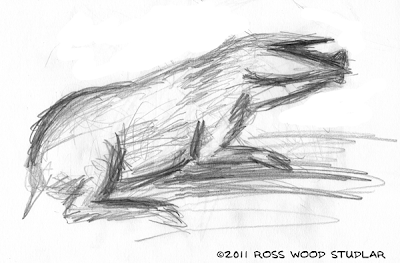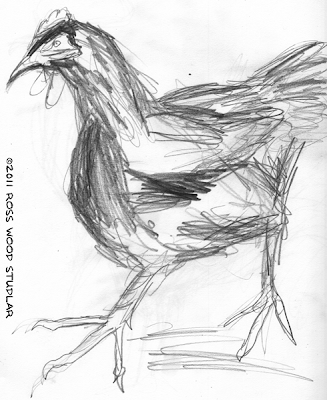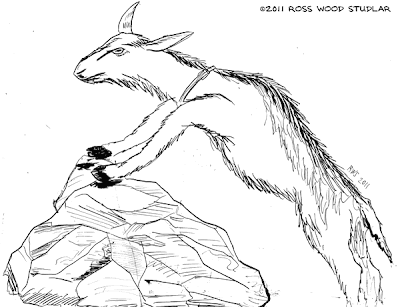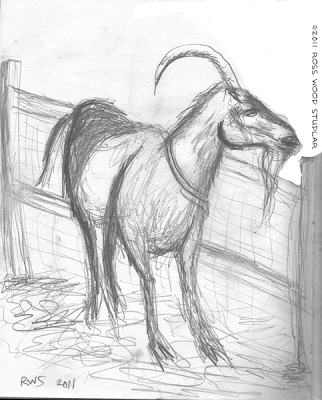Delilah the goat now gives milk in spades—up to four to six quarts a day. Harvesting the white liquid, however, has been a challenge for me. Until recently, I had never retrieved milk fit for human consumption from the dear goat. Every time, she kicked or knocked over or defecated in the bucket. What little milk was salvaged went to the young pigs.
This week, such results would not do us well. We had two children's camps in session (for 4-6 and 6-7 year olds), and both planned to make goat cheese. The pressure was on to keep them supplied.
I needed to improve the milk setup and improve my skills. First, I built a head catch for Delilah, based loosely on a diagram I found online, adapted for our specific stand. Next, Caitlin gave me a milking lesson, advice on how to lead the dance with the reluctant mammal. I learned from Caitlin a number of tricks and techniques, to supplement those I had earlier learned from Hannah.
Prior to bringing Delilah, we shooed visiting cats away and closed the milkroom doors—to block Delilah's biggest distraction, the baying of her kids. We brought her onto the stand. With head catch in place, the goat's range of motion was restricted—and she seemed calmer. Goats have two udders and humans have two hands, but we need several skills. First there is the pinch-and-squeeze with the fingers, which I can do well enough to get by, although my left hand is somewhat clumsy. Then, there is accuracy at milk-squirt, as one must fill a bucket through a small hole in its lid. Most importantly, however, one must learn to take calm control of the milking—strategically pet and massage the goat, feed her grain, push her against the wall when she attempts to jump over the bucket, and generally keep her feeling calm and snuggly... but also let her know who is boss. A multi-pronged challenge, like a karate match. And, like in a spar, one is wise to stay relaxed and fluent, despite the mental urge to tense up. And both activities feature a contact that does not break. Once one takes hold of the goat's udders, one should not let go until the milking session is over—much like the eye contact which does not break between the battling karateka. Although milking is not a fight, it is similar in being a game of control.
Tuesday night, it was my turn again to milk the goat. This time, I applied my new knowledge, and gathered one and a half useable quarts, one small squirt at a time. By the end, my hands were tired, but I felt like a child who had just rode a bicycle without training wheels for the first time.
At my next milking, Saturday morning, I generated two and a half quarts—enough to feed both Delilah's babies, and keep a bit for breakfast. (We allowed the babies to nurse for their first several weeks, but have now switched to bottle feeding; it is more work but makes them become friendlier to people.) Athena and Apollo suck heartily at plastic teat.
Back to Tuesday: After assembling my head-catch, I returned to the back pasture, to work on the hoop house (greenhouse). Throughout the week, the hoop house, which came as a giant assemble-it-yourself kit, has been an area of focus for us all. The instructions are barely decipherable, and the design is outrageously complicated. Hence, it has been cause of great frustration for some members of our team. Nonetheless, I always find it thrilling to build a purposeful structure. We dug post holes, ripped large rocks from the ground as they barred our path (they don't call this place Rock Bottom Ranch for nothing), placed the metal upright posts, assembled the archway, and generally bolted together many pieces of metal (and used all manner of tricks and levers to force the pieces together, as they didn't fit so well on their own.) We sweated and grunted through it, on the ground and on high ladders, under a hot sun. Progress on the greenhouse has been much slower than hoped. Even so, at the end of each day, progress is made.
On Tuesday, after a short time on the greenhouse, Amy announced her departure to deal with two chickens. One was a young meat bird, which had been run over by the chicken tractor, and had a broken hip. The other was an egg-layer, who was caught eating eggs. With such cannibalism, the hen negated her purpose on the farm. The sentence for both was death, with Amy and I as judge, jury, and executioner.
I hate to kill animals. I have done it several times. It has always made me feel like I will vomit, and made me think 'who made me god, to have the right to take life?' Curious then, that I am now a practitioner of animal agriculture, where killing animals is all in a day's work (although it does not yet feel that way to me.)
Here at the ranch, we try to give our animals the best possible lives, and the swiftest deaths. I took the egg-laying hen. I examined the Storey's Guide to Raising Chickens (a valuable book which we used both at The Homestead and here.) It described the way to kill a chicken instantly: to dislocate its head from the neck. I remembered how we used this method at The Homestead, but encountered difficulties in executing the process by hand. Storey's next paragraph had a solution: use your feet, and a broom. I read it carefully. I took hold of the hen, placed its head under the broomstick, stood with one foot on each side, anchoring broom and head flat against the ground. I gave the bird's feet a swift, hard pull. I not only dislocated the neck, but pulled the head off completely. The bird went into death throes, and spattered blood all about. Surprised, I dropped the flailing bird. It did somersaults over the ground, as the postmortem electricity surged through it. Other chickens trotted over, and pecked at their sister's detached head. Evidently, they don't share our taboos on cannibalism.
Although it may sound gruesome, the method has its advantages. It is easy to execute, and kills the bird in an eye-blink. Another common way to slaughter a chicken is to put it in a killing-cone, and cut its jugular vein. I am less impressed by this technique, as the bird may suffer for several minutes, while it bleeds out.
The chicken is now in the crockpot. Delilah is out grazing on grass and flowers and aspen leaves. The other laying hens roam about the ranch, pawing the earth in search of worms and seeds. They enter their coop to lay eggs. Inside, I continue to find eggs that were pecked open. I patched a hole through which magpies had been entering, but the problem persists. Evidently, another egg-eating hen is on the loose. We shall keep watch.
The baby goats frolic about the yard. Athena has grown her own tiny udders. One day, she will join her mother among the milk-givers. She will present new challenges at the milk-stand. Every goat is different, and I still have so much to learn.
Hoop house photo by Caitlin Bourassa; everything else by yours truly.













